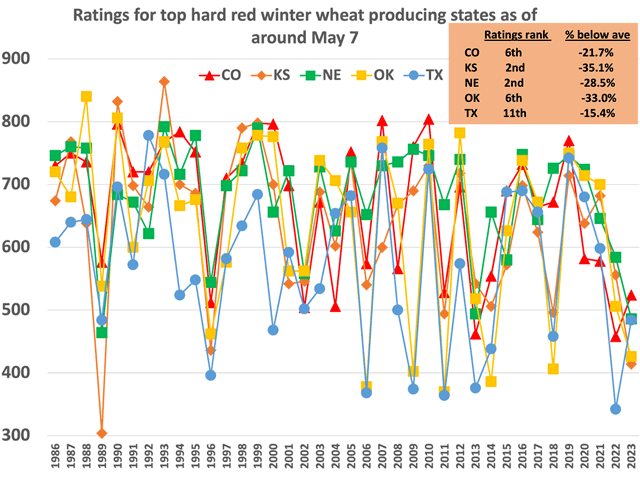Fundamentally Speaking
Expectations for the Wheat Quality Council's Kansas Wheat Tour
The Wheat Quality Council will have their annual tour of Kansas wheat fields starting next week and based on tour estimates in surrounding Plains states, the abysmal condition of that state's crop as indicated by the latest USDA condition report ratings and producer reports from the fields, the results are expected to be rather dreary.
As noted in prior blogs, the ongoing drought in much of the Southern Plains has persisted even as other areas of the country have seen a good improvement in drought conditions since the beginning of the year.
P[L1] D[0x0] M[300x250] OOP[F] ADUNIT[] T[]
This week's US Drought Monitor map shows widespread severe to even exceptional drought over much of Nebraska, Kansas, Oklahoma, Texas and even into Colorado, all major producers of the hard red winter wheat variety.
This graphic shows the conditions for these states' winter wheat crop right around May 7 using our usual rating system where we weight the crop based on the percent in each category and assign that category a factor of 2 for very poor, 4 for poor, 6 for fair, 8 for good, and 10 for excellent and then sum the results on the lefthand axis.
Of these five states two, Colorado and Texas actually have crop ratings above the year-ago levels though both coming off 2022 seasons when their crop ratings as of May 7 were the worst since USDA started winter wheat crop ratings in 1986 with Colorado's current 524 rating 21.7% below the 1986-2023 average and Texas at 484 15.4% below this average.
Kansas, the largest wheat producing state, has a rating of 414 which other than 1989 is the worst ever and 35.1% below its average, while Nebraska at 486 is also seeing its second worst rated crop ever at 28.5% below its 1986-2023 average. Oklahoma's 426 rating is the sixth worst since 1986 and is 33.0% below its average.
Needless to say, this portends yields well below trend and a very low harvested-to-planted ratio similar to what was seen a year ago.
(c) Copyright 2023 DTN, LLC. All rights reserved.






Comments
To comment, please Log In or Join our Community .